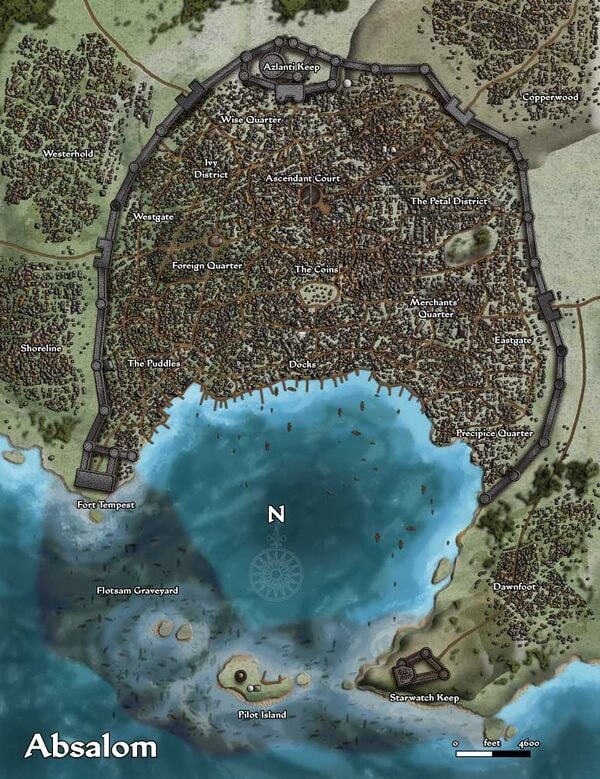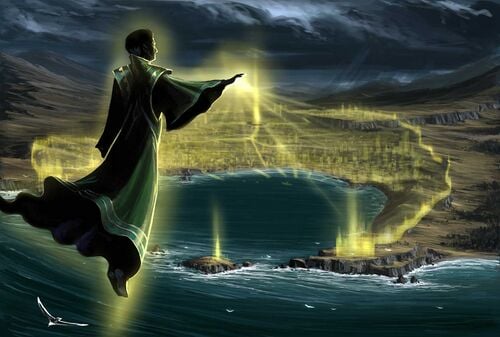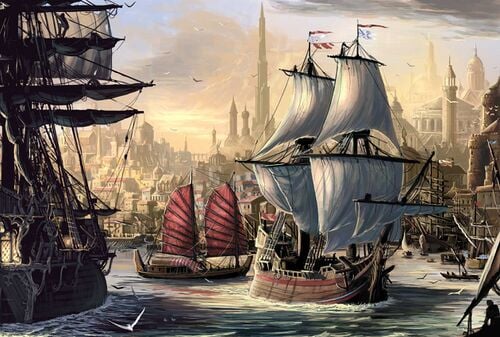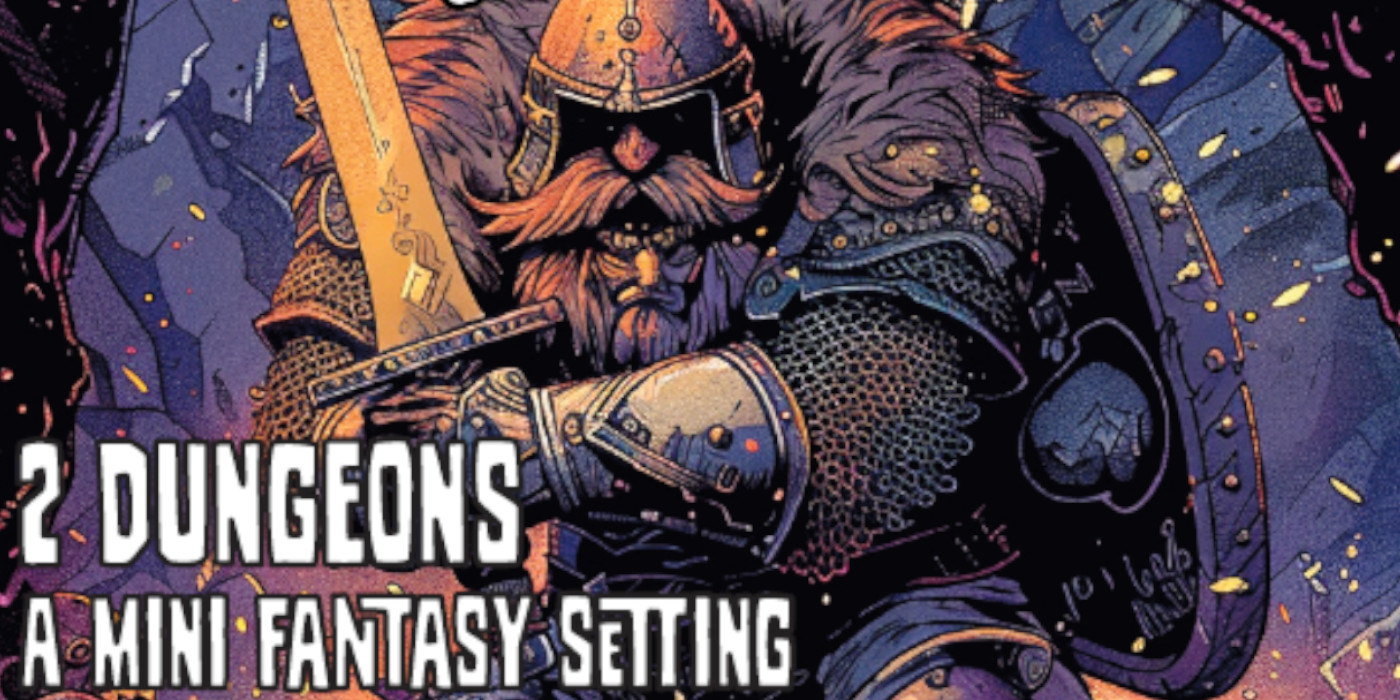Pathfinder: Absalom City – An Adventurer’s Guide

For more than 4,000 years, the City at the Center of the World, known as Absalom, has been the heart of Golarion.
Pathfinder‘s world, Golarion, is vast and varied. And at the heart of it all, a single city. A metropolis-sized showcase of all the world’s greatest treasures. Absalom, the City of Lost Omens, is the reason the Inner Sea is the most talked about region in Pathfinder.
For the city is not only a key strategic holding, it’s also a hub of trade, of diplomacy, and more to the point, it haas been the site of the ascension of four different deities. It’s the reason that time is marked by Absalom Reckoning. But why is this city so important? And how did it come to be? Journey with us as we visit the City of Lost Omens.
Absalom City – Where and What
Absalom City is the largest city in all of Golarion’s Inner Sea region. It is, quite possibly, the largest city in the entire world. Situated on the southern coast of the Isle of Kortos, Absalom towers are both tall and wide. Reaching from Starwatch Keep to Azlanti keep, the city is more populous than anywhere else in the world.
And yet, it is a city that’s never been conquered. Throughout Absalom’s history, no army has managed to take it. In fact, the region surrounding Absalom is known as the Cairnlands, and it is littered with the wreckage of abandoned siege engines, protective earthworks, and other attempts to take the city by force.
And in the city’s harbor, ships have to maneuver carefully through the Flotsam Graveyard — the wreckage of the armadas of ages past who, likewise, attempted to invade the city from the sea.
Absalom is split up into a handful of distinct districts. Each district has a life of its own. From the high-class Petal and Ivy districts to the more knife-y districts of Puddles and Precipice. There’s a district for just about anyone of any social standing in Absalom.
Besides the Carinlands and Flotsam Graveyard, there is also a darker, Shadow version of the city, known as Shadow Absalom, which inhabits the city’s space on the Plane of Shadow. So visitors should take care not to wander into dark alleys on moonless nights, lest they wind up in the Court of Shadows.
Lifeblood of Golarion
Money makes the world go ’round. And Absalom is the axis upon which it turns. Trade drives the city’s growth and livelihoods. The city’s rulers, of course, ensure that all policies and regulations serve to benefit commerce (and any rulers who happen to benefit as a result are purely coincidental, we’re sure). Taxes are generally light, though the city charges its inhabitants for access to roads, sanitation, and other public infrastructure.
Between the fees to inhabitants, taxes on foreign merchants, docking fees, and fees for pilots helping to navigate the Flotsam Graveyard, the city’s upkeep is entirely taken care of. Meaning that the economy generates massive wealth for the city’s inhabitants. If they can manage to hang on to it.
There are three basic sections: crafters and artisans, who make things, traders, who sell them, and of course, laborers who provide the services that maintain the other two. Absalom’s trade sees goods from around the world come through the walls. The Grand Council, a council of twelve high seats, administrate the city, though their primary duties are making sure that money flows in.
A Fallen Star
But Absalom was not always thus. It was founded more than four thousand years ago. If the stories are to be believed, it was founded by the god Aroden, who raised a magical artifact known as the Starstone, from the depths of the Inner Sea. The Starstone was a gemstone meteorite, broken off from a massive meteoroid that struck Golarion almost 1300 years before Absalom’s foundings.
Now the Starstone provides a pathway to godhood. Those who pass the Starstone’s mysterious trials are said to unlock the secrets to divinity. In this way, four different gods have risen to the ranks of divinity from humble mortals. Now, dreamers and adventurers of all sorts flock to the city to try their luck. Though it seems that one god per millennia is about the average rate of success.
The Long Siege
Of course, a city with a clear path to ultimate power will surely be a prize for any would-be warlord and conqueror. Why then, have none succeeded? Absalom endured centuries of assault. Whether one army or another or even dire enemies banding together to assail the city, none have succeeded.
For the first few hundred years, Aroden, the divine founder of Absalom protected the city. But others came to its defense. Absalom’s inhabitants have a stubborn pride in their ability to repel invaders. Absalom has been assaulted by metal automatons by another world, sea ghouls, hordes of undead, demons, gods, and spies. But none have succeeded. Some say Aroden still protects the city.
But most agree that it’s because the people of Absalom seem to have called first dibs on sacking the city.
Recent Years
In recent years, Absalom has seen much change. Riots and uprisings have become much more widespread throughout the city. After the death of its former Primarch, Absalom’s power existed in a vacuum, leaving many to vie for the seat at the head of the Grand Council. Riots and saboteurs fought proxy battles for nations.
And though the current Primarch has quelled the warring factions, it’s only a matter of time before the intrigue bubbles over. To make matters worse, a terrible earthquake recently sank much of the city into the sea.
As disaster looms for the city, its people — and its Pathfinders in particular, look to the future to see what heroism awaits.
Happy Adventuring









